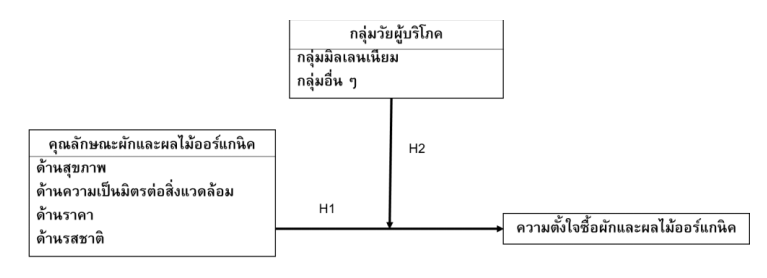The Effect of Organic Vegetables and Fruits’ Attributes On Consumers’ Purchase Intention in Different Generations
DOI:
https://doi.org/10.14456/psruhss.2024.22Keywords:
Organic, Purchase intention, Attributes, Millennials, GenerationAbstract
The objectives of this study are to investigate the influence of the attributes of organic vegetables and fruits together with purchase intention as well as consumers’ generation. In this study, the population is consumers, who are experienced in organic vegetables and fruits. The information was gathered utilizing online surveys, with 388 respondents and an 83.44 percent response rate. Multiple regression analysis was used for the statistical analysis. The findings indicate that customers are concerned about all four aspects of organic product, including healthfulness, environmental friendliness, cost, and flavor. These four attributes are positively encouraged consumers for purchasing organics product. In contrast, there is no effect between consumers’ generation to the attributes of organic product and purchase intention. According to this study, while designing a product strategy, organic vegetable and fruit business owners should take into account the four characteristics of these products to magnify purchase intention of all consumers’ generation.
References
Asif, M., Wang, X., Nasiri, A. B., & Ayyub, S. (2018). Determinant factors influencing organic food purchase intention and the moderating role of awareness: A comparative analysis. Food Quality and Preference, 63, 144-150. DOI:10.1016/J.FOODQUAL.2017.08.006
Botonaki, A., Polymeros, K., Tsakiridou, E., & Mattas, K. (2006). The role of food quality certification on consumers' food choices. British Food Journal, 108(2), 77-90. https://doi.org/10.1108/00070700610644906
Chaiyakarn, Zheng, J., & Nakornchaigul, K. (2020). Factors Influencing Consumer Intention to Purchase Organic Food in Ubon Ratchathani Province, Thailand. Dusit Thani College Journal, 14(1), 241–253.
Cochran, W. G. (1963) Sampling Technique (2nd Ed.). New York.: John Wiley and Sons. https://doi.org/10.1002/bimj.19650070312
Curvelo, I., Watanabe, E., & Alfinito, S. (2019). Purchase intention of organic food under the influence of attributes, consumer trust and perceived value. Revista de Gestão, 26(3), 198-211.
Department of international trade promotion, Ministry of commerce. (2019). Organic market in Australian. Retrieved April 2021, from https://www.ditp.go.th/contents_attach/561959/561959.pdf
Food and Agriculture Organization of the United Nations. (2021). The International Year of Fruits and Vegetables. Retrieved August 2021, from http://www.fao.org/documents/card/en/c/cb2395en
Hair, J. F., Black, W. C., Babin, B. J., & Anderson, R. E. (2010). Multivariate Data Analysis (7th Ed.). New York: Pearson.
Hair, Jr., J. F., Black, W. C., Babin, B. J., & Anderson, R. E. (1998). Multivariate Data Analysis with Readings. Englewood Cliffs, NJ: Prentice-Hall.
Hjelmar, U. (2011). Consumers’ purchase of organic food product. A matter of convenience and reflexive practices. Appetite, 56(2), 336-44.
Hoyer, W. D., Pieters, R., & Maclnnis, D. J. (2013). Consumer behavior. Australia: South-Western.
Hwang, J. (2016). Organic food as self-presentation: The role of psychological motivation in older consumers' purchase intention of organic food. Journal of Retailing and Consumer Services, 28, 281-287. DOI:10.1016/j.jretconser.2015.01.007
Jang, Y., Kim, W.G., & Bonn, M. (2011). Generation Y consumers’ selection attributes and behavioral intentions concerning green restaurants. International Journal of Hospitality Management, 30, 803-811. DOI:10.1016/J.IJHM.2010.12.012
Laothong Meesakul, S. (2016). [TK DreamMakers] Generation gap. Retrieved April 2021, from https://www.schoolofchangemakers.com/
Lee, H., & Yun, Z. (2015). Consumers’ perceptions of organic food attributes and cognitive and affective attitudes as determinants of their purchase intentions toward organic food. Food Quality and Preference, 39, 259-267. DOI:10.1016/J.FOODQUAL.2014.06.002
Madahi, A., & Sukati, I. (2012). The effect of external factors on purchase intention among young generation in Malaysia. International Business Research, 5(8), 153-159. DOI:10.5539/IBR.V5N8P153
Mearngkaew, T. (2020). Organic 2565. Retrieved August 2021, from https://www.thansettakij.com/content/Macro_econ/449957
Menard, S. (2002). Applied Logistic Regression Analysis. Sage Publications: Thousand Oaks.
Mernjang, P. (2015). Research and Development of organic agriculture. Department of Agriculture.
Molinillo, S., Vidal-Branco, M., & Japutra, A. (2020). Understanding the drivers of organic foods purchasing of millennials: Evidence from Brazil and Spain. Journal of Retailing and Consumer Services, 52, 101926. DOI:10.1016/j.jretconser.2019.101926
Nunnally, J. C. (1978). Psychometric theory (2nd ed.). New York: McGraw-Hill.
Padel, S., & Foster, C. (2005). Exploring the gap between attritudes and behaviour understanding why consumers buy or do not buy organic food. British Food Journal, 107(8), 606-623.
Patel, J., Modi, A., & Paul, J. (2017). Pro-environmental behavior and socio-demographic factors in an emerging market. Asian Journal of Business Ethics, 6, 189-214. https://doi.org/10.1007/s13520-016-0071-5
Peter, J. P., & Olson, J. C. (2008). Consumer behavior and marketing strategy. Boston: McGraw-Hill/Irwin.
Phanichpuk, P. (2021). Parin supported technology to develop organic agriculture. Retrieved August 2021, from https://www.thansettakij.com/content/politics/472484
Pieniak, Z., Verbeke, W., Vermeir, I., Bruns⊘, K., & Olsen, S. O. (2007). Consumer Interest in Fish Information and Labelling: Exploratory Insights. Journal of International Food & Agribusiness Marketing, 19(2–3), 117–141. https://doi.org/10.1300/J047v19n02_07
Piriyakul, M. (2015). Moderator and mediator in structural equation modeling. The Journal of Industrial Technology, 11(3), 83-96.
Prakash, G., Singh, P. K., & Yadav, R. (2018). Application of consumer style inventory (CSI) to predict young Indian consumer’s intention to purchase organic food products. Food quality and preference, 68, 90-97. https://doi.org/10.1016/j.foodqual.2018.01.015
Roberts, A. J. (1996). Green consumers in the 1990s: Profile and Implications for Advertising. Journal of Business Research, 36, 217-231.
Roitner-Schobesberger, B., Darnhofer, I., Somsook, S., & Vogl, C. R. (2008). Consumer perceptions of organic foods in Bangkok, Thailand. Food Policy, 33, 112-121. DOI:10.1016/J.FOODPOL.2007.09.004
Sa’ari, J. R., & Koe, W. L. (2014). The intention to consume organic food among millennial generation. In Proceedings Knowledge Management International Conference (pp. 920-925).
Saba, A., & Messina, F. (2003). Attitudes towards organic foods and risk/benefit perception associated with pesticides. Food Quality and Preference, 14, 637-645. DOI:10.1016/S0950-3293(02)00188-X
Singh, A. R., & Verma, P. (2017). Factors influencing Indian consumers' actual buying behaviour towards organic food products. Journal of Cleaner Production, 167, 473-483. DOI:10.1016/J.JCLEPRO.2017.08.106
Thai business information center in USA. (2019). The Organic market’s opportunity in USA. Retrieved August 2021, from https://www.thaibicusa.com/2019/06/24/organic/
Torjusen, H., Lieblein, G., Wandel, M., & Francis, C. (2001). Food system orientation and quality perception among consumers and producers of organic food in Hedmark County, Norway. Food Quality and Preference, 12, 207-216. DOI:10.1016/S0950-3293(00)00047-1
Ueasangkomsate, P., & Santiteerakul, S. (2016). A Study of Consumers’ Attitudes and Intention to Buy Organic Foods for Sustainability. Procedia environmental sciences, 34, 423-430. DOI:10.1016/J.PROENV.2016.04.037
Wee, C. S., Ariff, M. S. B. M., Zakuan, N., Tajudin, M. N. M., Ismail, K., & Ishak, N. (2014). Consumers perception, purchase intention and actual purchase behavior of organic food products. Review of integrative business and economics research, 3(2), 378-397.
Willer, H. & Lernound, J. (2018). The world of organic agriculture: statistics and emerging trends 2018. FiBL-IFOAM report, Research Institute of Organic Agriculture (FiBL), Frick, and IFOAM-Organics International: Bonn
Xie, B., Wang, L., Yang, H., Wang, Y., & Zhang, M. (2015). Consumer perceptions and attitudes of organic food products in Eastern China. British food journal, 117(3), 1105-1121. DOI:10.1108/BFJ-09-2013-0255
Zimmer, M. R., Stafford, T. F., & Stafford, M. R. (1994). Green issues: dimensions of environmental concern. Journal of business research, 30(1), 63-74. DOI:10.1016/0148-2963(94)90069-8

Downloads
Published
How to Cite
Issue
Section
License
Copyright (c) 2024 Humanities and Social Sciences Journal of Pibulsongkram Rajabhat University

This work is licensed under a Creative Commons Attribution-NonCommercial-NoDerivatives 4.0 International License.
Any articles or comments appearing in the Journal of Humanities and Social Sciences, Rajabhat Phibulsongkram University, are the intellectual property of the authors, and do not necessarily reflect the views of the editorial board. Published articles are copyrighted by the Journal of Humanities and Social Sciences, Rajabhat Phibulsongkram University.







